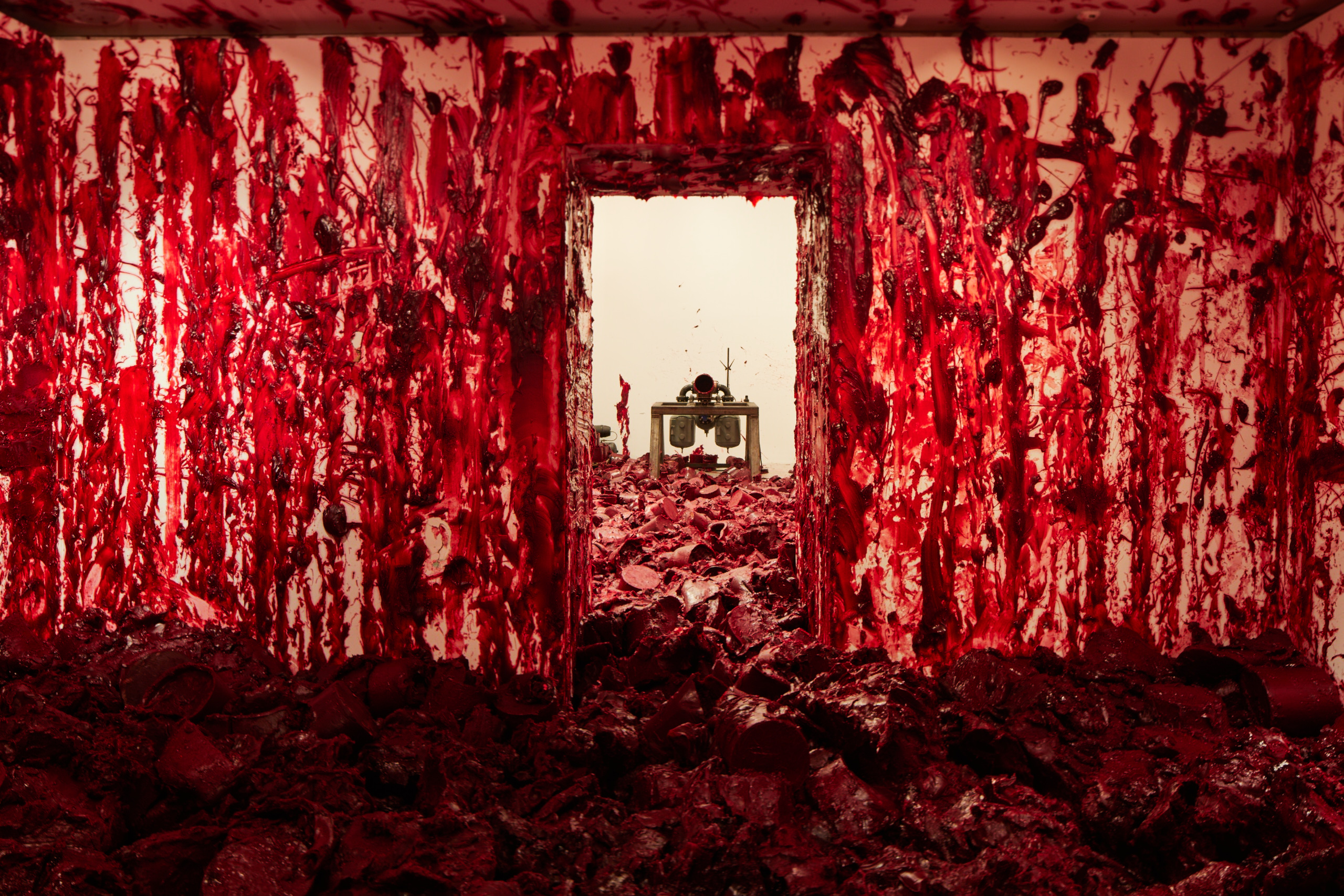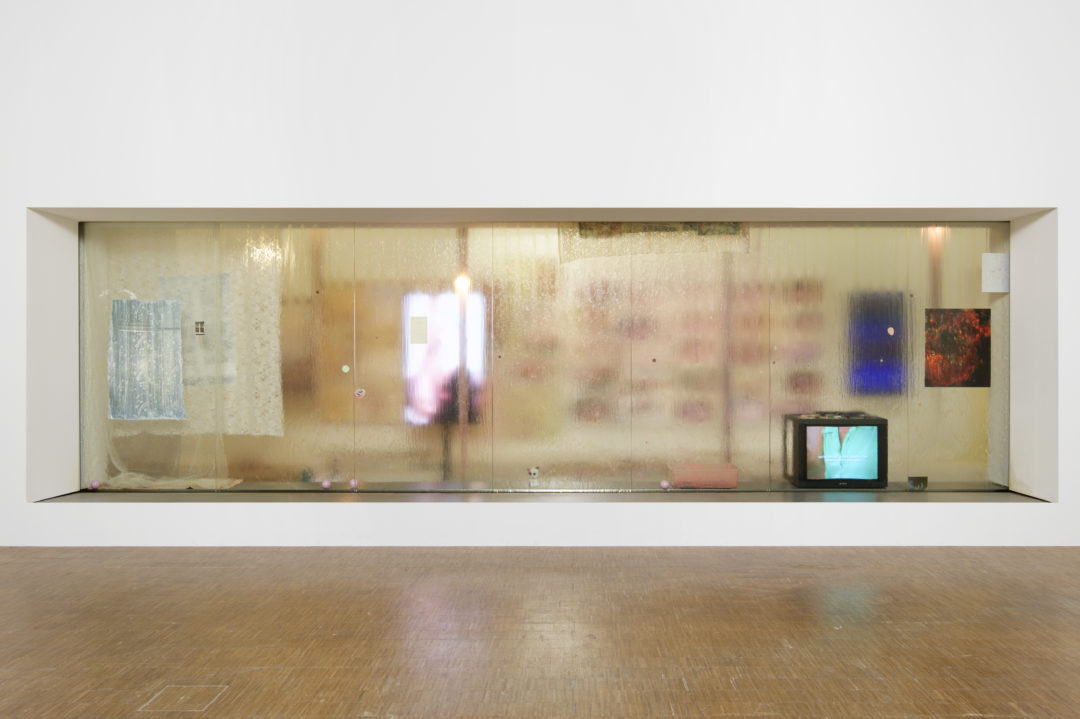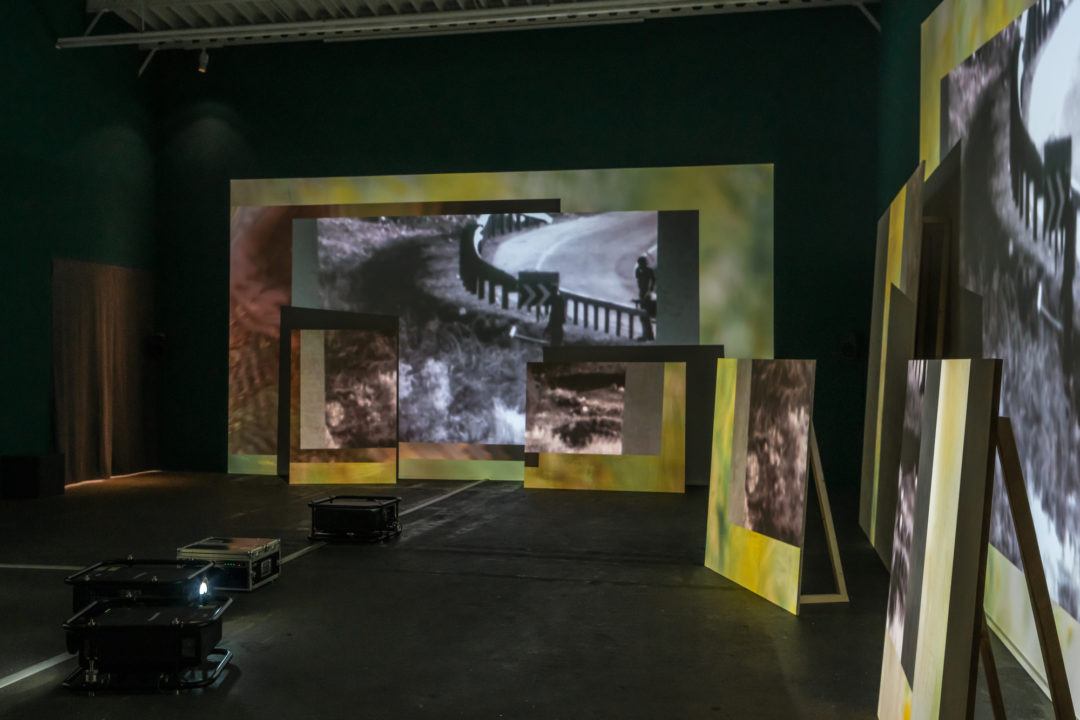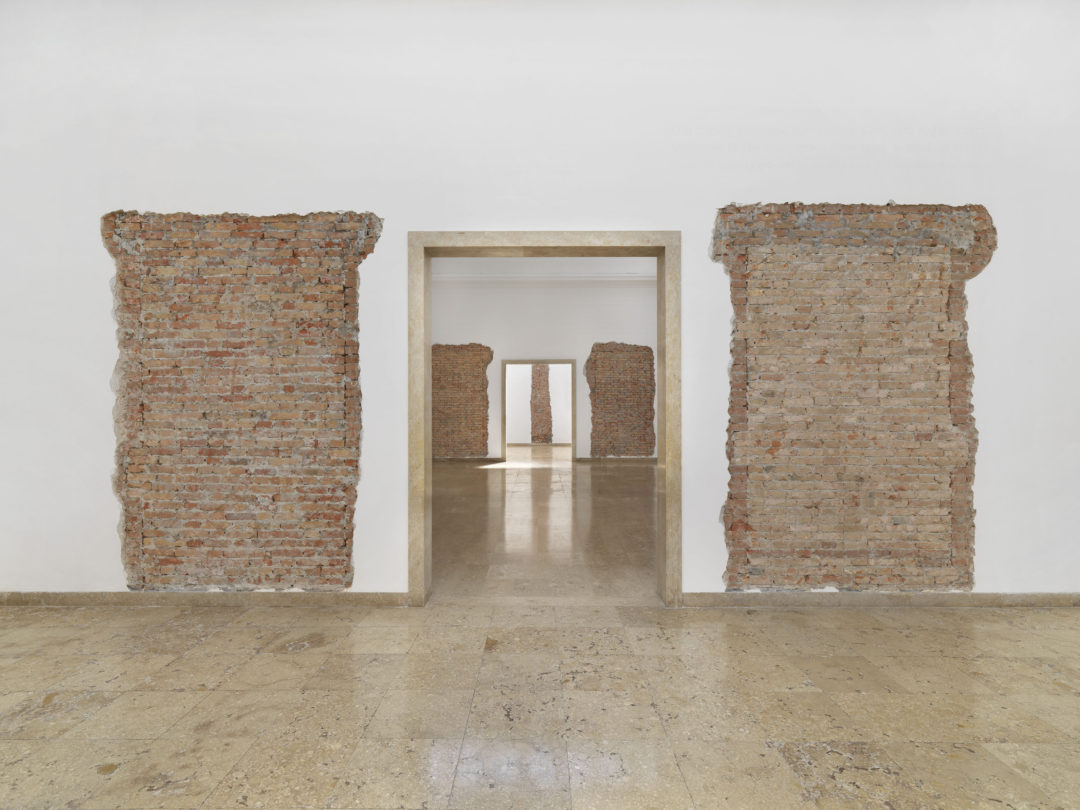Matter in Suspense

Art is rarely a mere window; a vantage point permitting us to take stock of the world, a verification that it is as it appears through the panes of glass. Rather, art is more often something like a ram charging through ceiling and walls, stirring things up, varying the outlines, their thickness, their pseudo-homogeneity through a political model evading any possible sabotage of the given—too pure, too rigid, precisely too much of a given. We will therefore need to learn to develop our sensibilities towards art in order to find a way forward despite an overall impression that this may be impossible. Tiepolo’s trompe l’oeil church ceilings, Gordon Matta-Clark and his three-dimensional holes in condemned buildings; both have showed us the way. Even Warhol defined his ideal sculpture as “a solid wall with a hole in it to frame the space on the other side.” (The Philosophy of Andy Warhol.)

Porous Screen
It is therefore possible to create an opening in a wall. Or to otherwise transform it into a fluid curtain (like Mimosa Échard, winner of the 2022 Marcel Duchamp prize). To modify its physical state, for instance, rather than break through it. To create a screen instead of a wall, one which may make us wonder if it filters the reality it covers up or if shows us yet “another world”, possibly becoming permeated by that which it had seemed to hold at a safe and reassuring distance until now. This separateness created by the flatness of the screen should be subject to scrutiny—think back to the 1980s when the television set became an intrusive body, a fist brandishing a pistol (in David Cronenberg’s Videodrome).
In any case, all of this frustrates the spectator’s capacity to comfortably project themselves into alternative worlds which are otherwise defined, centred, shared, but more importantly it makes communication difficult. Some works transform the wall into a screen, therefore, although they remain far from becoming fixed windows which look out on faraway worlds, far from a Biennale in Berlin or Venice, for example. Instead, there is a kind of materially-unstable threshold, a vague filter which (virtually) transports a non-Western “outside” as close as possible, not to a Western “inside,” but to a singular problematization of all notions of borders.
Several instances of this juxtaposition of concrete, tangible elements (placed on the ground or on top of a table) with the representation projected onto a wall of a world in which these same elements are found were present in Berlin. At the Akademie der Künste, Khandakar Ohida’s Dream Your Museum operated along these lines: a film showing the artist’s uncle, Khandakar Selim, as well as a few of the objects referenced, collected over the course of 47 years, were displayed in front of the screen, forming a small, scattered museum which could be handled by visitors. In a back-and-forth dynamic between the objects and the screen, these relics relayed the viewer from one period to another; between colonial and post-colonial, featuring the rural Muslim culture displayed. Metal trunks filled with and surrounded by objects concretised this memorial; sacred books and worthless objects meet a gramophone, old bottles of spirits, stamps and Indian DVDs. The objects are therefore no longer a straightforward reflection of troubled and irretrievable loss, a ceaseless cataloguing which constantly defers its conclusion, as well as the resolution of these historical and personal conflicts. Instead, this recovered cadence of counterpoint involves the senses in a polyrhythm: that of the objects toward the screen, awaiting the moment where the echoes of the objects appear, and that of the screen toward the objects, which are no longer simple objects but punctuation marks on the timeline of the history of India. Between what is projected and what is presented, an invisible exchange emerges, as if by magic, from the developed porosity of the screen. In addition to this features a conversation centring around the fear of loss. The screen shows the dreamlike discussion between the old man and a young girl, who questions the man about these same objects. The result of this intergenerational exchange is that the young girl is left to drift off into another dimension, a “dreamworld,” filled with desire and uncertainty, obliqueness and unpredictability, one which differs from that of the abrupt, horizontal, definitively immobile, of loss.
Objects can therefore filter through the screen, resisting disappearance while gaining a soul, creating connections between lives despite the distance separating them. And what happens when absence itself affects the screen, displacing it slightly, investigating the difficult resistance of the archive in a much more violent way—its physical state dangerously close to disappearing? In the installation Oh Shining Testify, Palestinian artists Basel Abbas and Ruanne Abou-Rahme relate a different sort of shared moment: the tragic death on March 19th, 2014 of a young boy at the Israel-Palestinian border near Hebron in the West Bank under gunfire by Israeli forces. Images projected onto three walls of a space in the Hamburger Bahnhof depict low-quality video surveillance footage of the young man, gone out foraging for plants, alternating with scenes of destruction, of a party (or a funeral?), of the sky, the sun and the moon, and of the plant in question (a wild artichoke). There is also blankness, a kind of lacuna which creates space between two slides, calling attention to the simplicity of the set up. The installation partially breaks up the screen through the use of multiple wood panels of varying dimensions. The resulting image—already broken up into multiple, overlapping images—is full of holes and space, with dark shadowy areas which fall into the spaces between the wood panels. At the same time, continuity is alluded to through the recorded dialogue which communicates the injustice of the dramatic event described here; one which is not singular but plural, repeating itself over a grand historic scale. Artistic experimentation which focuses on a recent tragedy can in this case only hope to deliver a modest monument to the resistance of the archive, with its ceremonial or poetic relays, in an effort to contain the loss. A monument propagating sound and light waves, both furtive and active, a testimony to the difficulty of making broken bodies visible, while also doing justice to them. A monument to the absence alluded to in the cracks between the panels which is elegiac rather than magical. The words projected there transmit a message which references a life gone missing: Send my love.

States of Matter
The wall onto which the world is again projected thus loses some of its solidity, allowing elements from lived experience or the traces of a conflict with no end in sight to filter through. In these interstices, the screen can no longer show much of anything, although it does send off vibrations, breaks apart, or otherwise becomes disrupted while evoking: through voice (ex-vocare), through sound, an element which is often forgotten, left until the very end. And yet, sound may be the very agent through which reality manages to express itself in a different way than through the inadequate surfaces which mediate it, oftentimes numbing our attention. The problem remains a material one, where physical rhymes with political. Art certainly does little other than this: joining together two words which are generally far apart from one another, the separation becoming unstable matter, a disjointed joining, always saying the same thing: a (collective?) feeling of having to escape a trap that has been set, for example, as is the case in an ecologically and militarily threatening world, where tides are rising, rivers evaporating, nuclear plants are under pressure, and dresses are sprayed on and then dissolve.
Le mur où se projette encore le monde perd ainsi de sa solidité pour laisser passer des choses de la vie vécue ou les traces d’un conflit sans issue. Dans ses interstices, l’écran ne montre plus grand-chose, mais vibre, se défait ou se trouble en évoquant : en faisant sortir par la voix (ex-vocare), par le son, qu’on a toujours tendance à oublier un peu, à garder pour la fin. Or c’était peut-être lui l’agent de cette porosité où le réel se dit autrement que sur ces pauvres surfaces interposées qui abrutissent le plus souvent notre attention. Reste un problème de matière, où physique rime avec politique. L’art ne sert à pas grand-chose d’autre, sans doute : faire rimer deux mots habituellement éloignés, et dont l’éloignement devient forme instable, accord même désaccordé, pour dire toujours la même chose : le sentiment (commun ?) d’un piège dont on voudrait échapper, comme d’un monde écologiquement et militairement angoissant, où l’océan monte, les rivières s’évaporent, les centrales nucléaires sont sous pression,
Once we have put aside a mimetic need to see the world we are already on familiar (but bad) terms with reflected back at us, let us make a different, more dizzying hypothesis. What if the porosity, the viscosity, the liquefaction or evaporation we see in many works of contemporary art came not from the works themselves but rather from the disruptive imaginary screen they somewhat nonchalantly interpose, between us and the objects? One of a world recalled or invented, of a traumatic scene endlessly re-prefaced, located somewhere between critical distance and ceaselessly menacing phobia.
And yet, once our trust in the flat and reassuring stability of the screen (the modern equivalent of the humanistic trust in a unifying principal of perspective) has been betrayed, how can we re-learn to apprehend a reality which appears only faintly, and unclearly, in the disruptive context of the screen? What signs—even if vaguely— can still be deciphered, when their matter often gets mixed up with the materiality of the screen? Alternatively, they may escape us altogether, becoming immaterial, which amounts to the same thing. In fact, no, we will not all end up in a big Zoom reunion where nothing else but the screen matters, forever canceling all possibility of discreet agreement (just off-camera, in the shadows, in cold blood or in love, but more importantly: a physical one). Exactly which signs can still be made out? Provided we at least believe they can speak to us with all our complicated singularities.
In the unsettling, shadowy Malta pavilion at the Arsenal, drops of steel melted at very high temperature provide a furtive illumination in the space, where the drops fall from the ceiling into seven prepared containers. At the pavilion, Arcangelo Sassolino’s Diplomazija Astuta echos Caravaggio’s Beheading of Saint John the Baptist (painted in Malta in 1608), including its chiaroscuro with light cutting through the shadows while the blood drains away: a double physicality. Cycling through all of the states of matter (from the liquefaction of fused steel to the evaporation of water as it comes in contact), the installation shows nothing other than a sudden change of environment: the refraction—in its most concentrated, fleeting form, fully minimalistic—of a submerged drop. Despite the Duchampian inframince which differentiates each drop, they seem nonetheless to say the opposite of another of Duchamp’s enigmas which appears on the side of a comb: “3 or 4 fallen drops have nothing to do with savagery.” What do the small gold drops that fall from just a bit higher represent? Are they the fallen heads of victims to savagery? A volcanic rain? An extraterrestrial message which our slow brains cannot quite make out?
Here, physical sublimation (the evaporation of solid matter) combines with a hesitant psychic and aesthetic sublimation: that of the vertical gesture of the taking of a life (Caravaggio) converted into a multitudinous polyphonic scansion, always either calm or violent, refined composition (chiascuro), and industrial (serial repetition), optimised production (including from an ecological standpoint, through the recycling of the steel) and destruction in a purified but burning hot form, still a bit terrifying. The photographs of the installation prolong the shower of golden segments, a shower of arrows, as if another uncontrollable catastrophe had taken place, forgotten or in the future.

Moving away from the Venice Biennale, at the Accademia as well, eternally pared-down sublimity meets melting or rotting abjection in the Anish Kapoor double exhibition. The spectacular contrast between black-and-white, Apollonian abstraction and fleshy, Dionysian bloody meat is striking. Here we witness two extremes: ethereal sublimation keeping violence at a distance and viscous desublimation flattening us with its formless horror. Illustratively, we find ourselves with mouths hanging open in front of an enormous screen. Is there not another, more subtle contrast to convey? Absence of matter, or quite simply the air and light of a space that we pass through are often sufficient to bring subtle differences—physical, geophysical, stratigraphic and even historical—to the attention of our perception. After a short visit of the galleries in the cloister of San Francesco della Vigna, which is paved with the tombs of rich families whose coats of arms are slowly (and at no cost) crumbling, achieving anonymity with the help of time; in the Giardini, a similar effect can be seen, just as subtle only less anonymous. For example, the Spanish pavilion has undergone a 10-degree rotation in order for its walls to become aligned with the nearby pavilions (Ignasi Aballí, Correction). Elsewhere, we were witness to an in-situ example of the “1% of disorder” of Hungarian artist Vera Molnár, with variations on the “vulnerability of the right angle” in her geometric abstract paintings (on view in the central pavilion); a joyful encounter reminiscent of an enjoyable meeting or an unexpected, full-on, so-very-human free-for-all. Further on, the German pavilion uncovered the original 1909 brick version of its current architecture, built by the Nazi regime in 1938 (Maria Eichhorn, Relocating a structure).
Instead of building and stabilising, these works destroy or displace a small amount of matter, reinventing their situation, creating possibilities for new passages—beyond time, beyond the grave, beyond the pavilion. And yet, what good is there in going beyond the outer layer in order to turn a critical gaze towards what is hidden behind or below, if the resulting space itself is limited? Despair. On the other hand, the opposite is possible: an incessantly active hope, a ram charging again and again, like Albert Einstein’s photons, capable of exerting force on the matter in front of them—a “radiation pressure” whose measure was recently taken by an international team of astrophysicists. This luminescent wave with its becoming-particle (quantum physics is on the fence about whether to use the term wave or particle to define this “quantum” of light energy) therefore possesses a becoming-ram, moving through its environment in a constant state of affectedness, open yet held back, enlightened yet propelled by a rhythm which can be imagined as a slight syncopation—a little blip can be observed if you listen to a photon because it must push back at anything that may hold back its photon singularity, keeping it from becoming sensitive to the other photons alongside which it illuminates a small portion of the space-time continuum at a given moment. Picture the solitude of a photon, how it holds steady.
We have only to lend an ear. Listen to the falling light, or to that which bifurcates, and unfolds, while bifurcating, in a new direction: within memory and history, within faraway worlds or those right under our noses, within what remains the Western logic of nature (overly confident in its sadomasochistic (sadistic and masochistic) controlling way), or otherwise within life.
______________________________________________________________________________
1 See the recent Entretiens (Interviews) by Vera Molnár with Vincent Baby, Manuella éditions/AWARE, 2022.
2 « Isolated detection of elastic waves driven by the momentum of light », Nature, August 2018, https://www.nature.com/articles/s41467-018-05706-3.
Head Image : Anish Kapoor © Photo David Leven.
- From the issue: 103
- Share: ,
- By the same author: New Enumerations, Describe, Lighten,
Related articles
Toucher l’insensé
by Juliette Belleret
An exploration of Cnap’s recent acquisitions
by Vanessa Morisset
Curator’s marathon : Frac Sud, Mucem, Mac Marseille
by Patrice Joly

